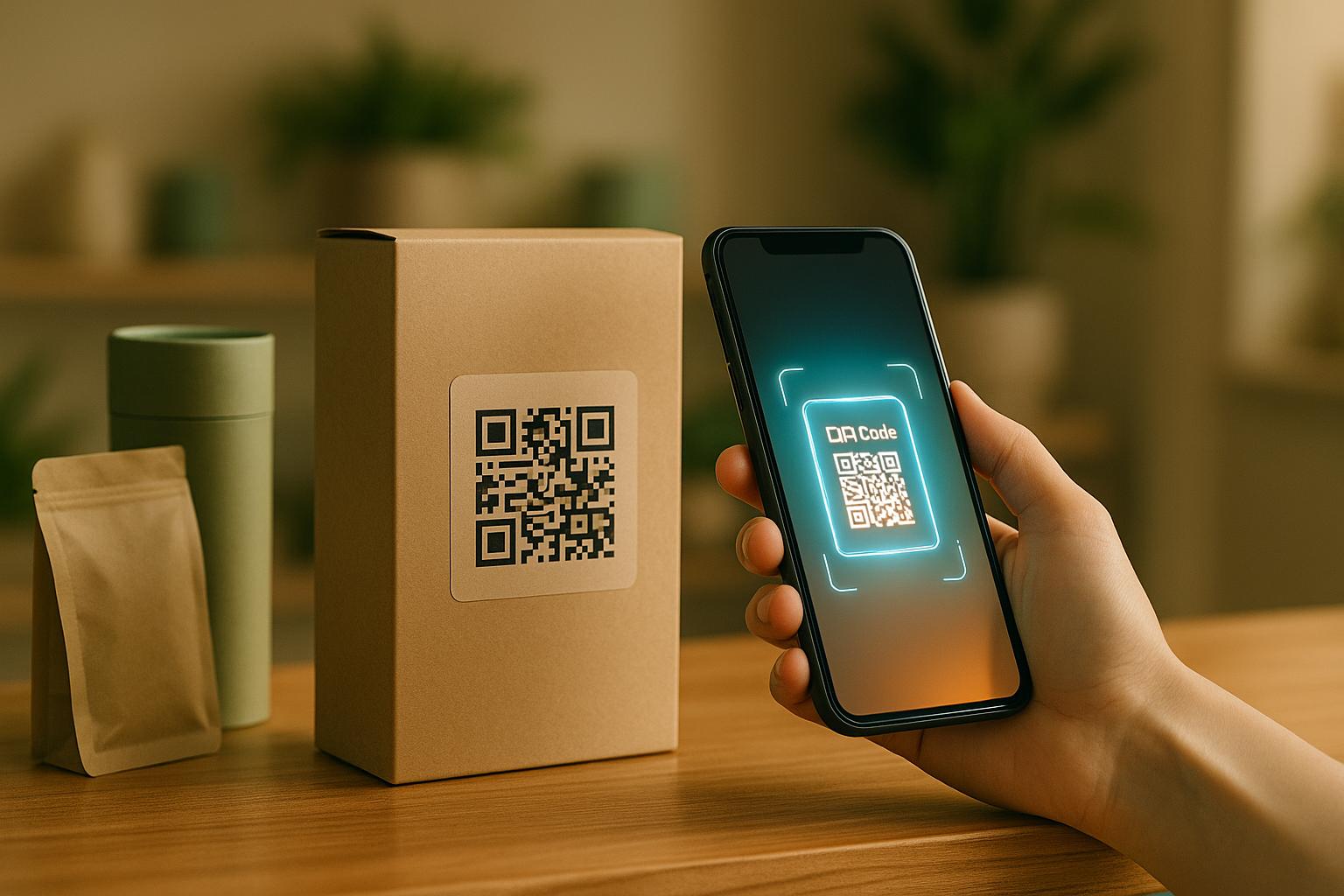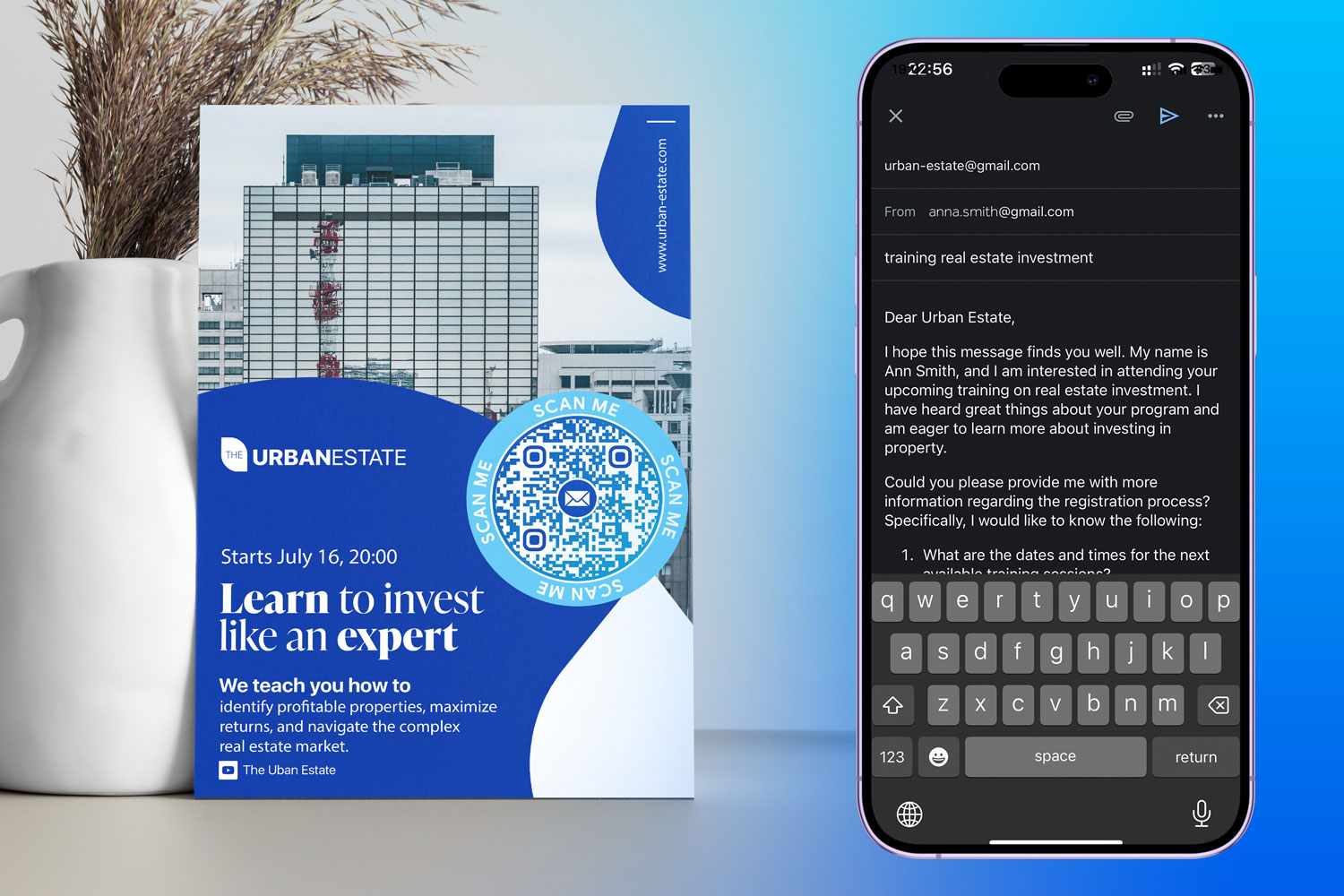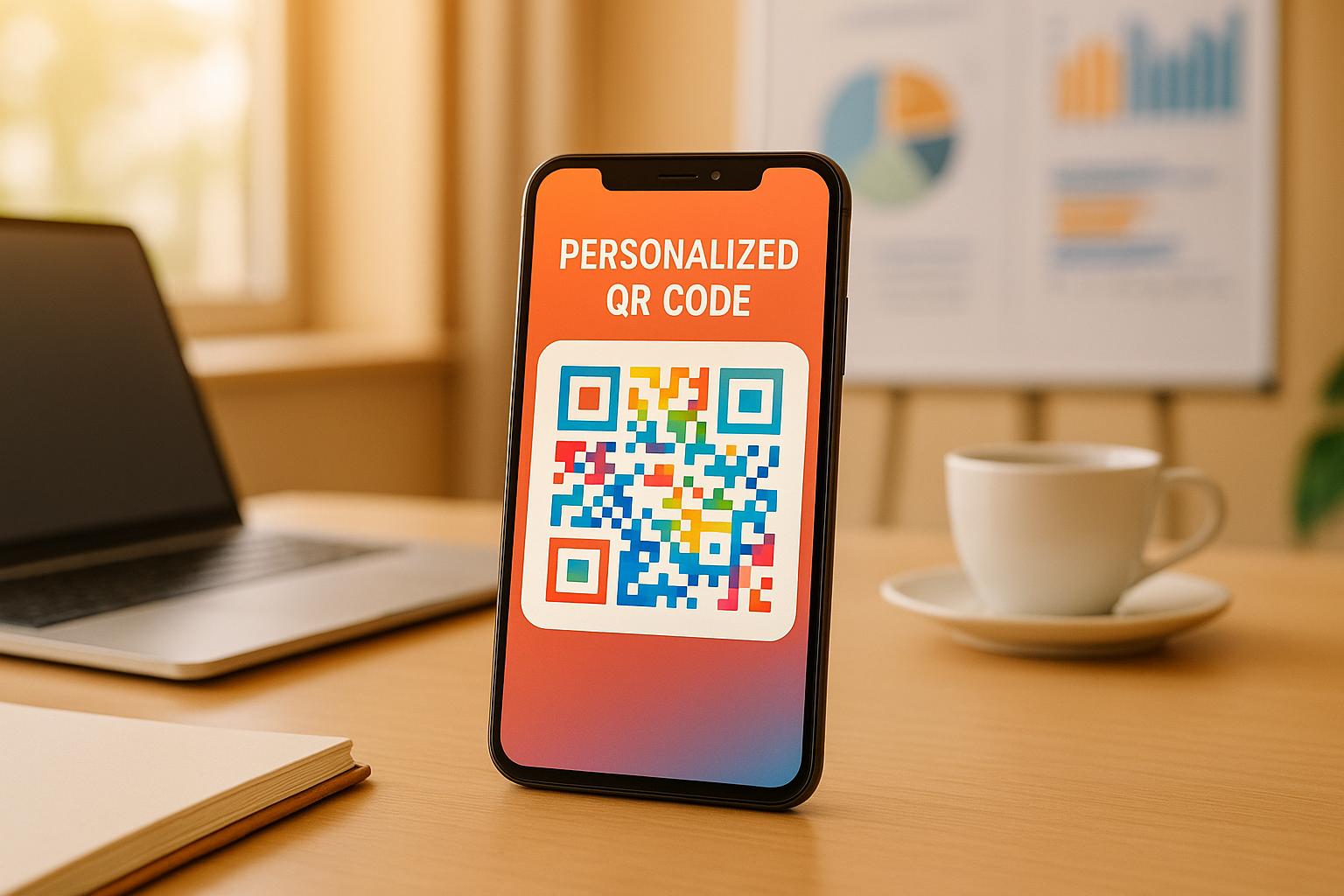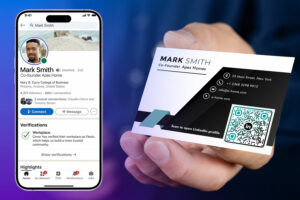Interactive packaging is changing how brands connect with customers. By incorporating QR codes into product packaging, businesses can provide instant access to digital content like videos, promotions, or product details – without cluttering designs. This approach drives customer engagement, offers actionable insights, and simplifies updates without reprinting materials.
Key Takeaways:
- What It Is: QR codes make packaging interactive, linking physical products to digital platforms.
- Why It Matters: Boosts customer interaction, tracks behavior, and supports real-time updates.
- Business Benefits: Higher sales (up to 47%), improved trust, and reduced production costs.
- Examples in Action: Coca-Cola uses QR codes for personalized promotions, while Danone ensures product authenticity with dual QR systems.
Dynamic QR codes stand out for their flexibility, enabling content updates and detailed analytics. Whether you’re sharing product details, launching promotions, or enhancing transparency, QR codes are becoming an essential tool for modern packaging.
How to Create a QR Code for Product Packaging
Benefits of QR Codes on Product Packaging
QR codes can turn ordinary product packaging into a marketing powerhouse. When used thoughtfully, these codes open doors to deeper customer connections, actionable insights, and memorable experiences that can boost both loyalty and sales.
Better Customer Engagement
QR codes make it easy to share a wealth of digital content without cluttering packaging. With a quick scan, customers can access videos, detailed instructions, exclusive deals, and personalized offers. This approach resonates – 43% of consumers actively use QR codes to learn more about products. By scanning, customers are voluntarily interacting with the brand, making them more open to its messages and promotions.
Take Absolut Vodka’s campaign in Italy, for example. They introduced personalized bottles with QR codes, enabling senders to attach voice notes, photos, and emojis. Recipients could scan the code to view these messages in augmented reality, turning the packaging into an interactive, heartfelt experience.
"They seek relevance, and the best advice is to include a clear call to action… Instead, it will connect them to a personalized mobile experience they will derive value from, not only with the first scan but with continued visits." – Dave Rogers, BlueBite
Additionally, QR codes can guide customers to online help centers for instant support. This not only reduces the strain on traditional customer service channels but also enhances the overall experience by offering quick solutions. These engagement strategies naturally lead to valuable insights, which brings us to the next advantage – data tracking.
Data Tracking and Analytics
One standout benefit of QR codes is the real-time data they provide. Unlike traditional packaging, QR codes offer a window into customer behavior, helping brands refine their marketing strategies.
Dynamic QR codes, for instance, deliver detailed metrics like scan locations, timing, and device types. These insights reveal patterns, such as peak engagement times or geographic hotspots. They also allow for A/B testing of different packaging designs or promotional messages. By assigning unique QR codes to each variation, brands can see which approach resonates most with customers.
Here’s an example: A real estate agency added QR codes to shopfront displays, giving passersby access to property details. The data showed when scans peaked, helping the agency adjust its displays and timing to attract more potential buyers. With tools like the free QR generator, businesses can create dynamic codes that adapt to their marketing needs in real time, making campaigns more agile and effective.
Personalized and Contactless Experiences
Dynamic QR codes shine when it comes to personalization. Unlike static codes, these can be updated instantly, offering content tailored to a customer’s location, time of day, or purchase history. For example, brands can use them to launch limited-time offers or region-specific promotions without reprinting packaging.
Personalization works – 80% of businesses report higher engagement when they tailor their interactions. QR codes make this possible by linking physical products to digital platforms that deliver customized experiences. Plus, their contactless nature is a major advantage. Especially after the pandemic, many consumers prefer touch-free interactions, whether it’s accessing product details, making purchases, or registering warranties. For e-commerce brands, QR codes can even guide customers to personalized reorder pages or loyalty rewards based on past purchases.
Building Brand Trust and Authenticity
QR codes can also be a tool for transparency, which is increasingly important to today’s consumers. These codes offer unlimited space to share details about ingredients, manufacturing processes, or a company’s sustainability efforts. They’re also essential for verifying product authenticity, especially for premium goods, pharmaceuticals, and luxury items.
Danone’s Track & Connect program is a great example. They placed two QR codes on baby formula packaging – one visible on the outside and another hidden behind a tamper-proof seal. This setup allowed customers to confirm the product’s authenticity and trace its production journey.
Oatly, on the other hand, used QR codes to connect customers to sustainability data. Their packaging revealed that their oat drinks have a 44–80% lower climate impact than cow’s milk, which helped them stand out with environmentally conscious shoppers.
QR codes can even link to authentic review platforms, further reinforcing trust and credibility. When adding a QR code to packaging, the goal should always be to provide genuine value that strengthens long-term relationships, not just drive one-off interactions.
QR Code Features and Customization for Packaging
QR codes are more than just functional tools – they can be visually appealing, strategically designed, and integral to boosting customer interaction. When used effectively, they transform packaging into both a branding element and a gateway to digital experiences.
Custom Branding with QR Codes
Maintaining brand consistency across all customer touchpoints is essential, and QR codes on packaging are no exception. Branded QR codes can increase scan rates by up to 80%, as they appear more trustworthy and professional compared to generic black-and-white designs.
Today’s QR code platforms allow for extensive customization. You can incorporate your brand’s colors, embed your logo in the center, and even adjust the shape of the code’s data modules to align with your overall packaging design. These tweaks ensure the QR code feels like a natural part of your branding. However, it’s crucial to maintain enough contrast between the code’s foreground and background to ensure it scans reliably. Tools like Pageloot‘s QR code generator provide templates that combine aesthetics with functionality, making it easier to achieve this balance.
By blending creativity with practicality, branded QR codes not only enhance the visual appeal of your packaging but also pave the way for dynamic content updates.
Dynamic QR Codes for Flexibility
Dynamic QR codes are a game-changer when it comes to keeping content fresh without having to reprint packaging. They allow you to update the destination URL for the code, making them perfect for seasonal campaigns, product updates, or quick responses to market changes.
For instance, Marriott Aruba replaced traditional print menus with dynamic QR codes after COVID-19, saving around $150,000 in printing costs. Similarly, Lionsgate used dynamic QR codes for localized marketing, enabling them to adjust promotional destinations without reprinting materials. A digital marketing consultant noted the importance of this flexibility:
"I wanted the ability for the QR Codes we deploy to change their destination, whether a different giveaway, sweepstake, or any type of promo. We also didn’t want to print the same collateral en masse twice".
With dynamic QR codes, you can update promotions, add seasonal content, or tweak product details, all while using the same printed materials. Platforms like Pageloot’s dynamic QR code generator make it easy to manage these updates and keep your campaigns relevant.
Security and Safe User Experiences
While QR codes themselves are safe, the URLs they link to can pose risks if not managed carefully. The main concern comes from malicious links embedded by attackers, not the codes themselves. For packaging, the risk is lower since customers generally trust codes on products they’ve purchased. However, it’s still essential to use reputable QR code platforms with built-in URL verification and monitoring systems to detect and block suspicious activity.
To further enhance security, ensure that destination URLs use HTTPS, and monitor for unusual scan patterns. Transparency also plays a key role – most smartphones display the destination URL before opening it, allowing users to verify its legitimacy. Using branded, clean URLs reassures customers and strengthens trust. With these precautions in place, QR codes can deliver not only safe but also engaging experiences.
Analytics and Marketing Automation
The real strength of QR codes lies in their ability to provide deep insights into customer behavior. Dynamic QR codes can track data like scan location, time, device type, and even demographics. These insights help businesses identify peak engagement times, geographic trends, and the effectiveness of their promotions.
Campaign labeling is another useful feature, simplifying the process of analyzing and organizing metrics for specific campaigns. For example, one organization used dynamic QR codes to generate over 148,000 visitor engagements and 113,000 unique interactions. Additionally, supporting multiple languages can broaden your reach and improve engagement with diverse audiences.
This level of data integration elevates QR codes beyond simple links, turning them into powerful tools for driving and sustaining customer engagement.
How to create and manage QR codes for packaging
QR codes can serve as a bridge between your product and digital content, making your packaging more interactive and engaging. Here’s how to create, design, and manage them effectively.
Using a QR code generator
When choosing a QR code generator, go beyond basic functionality. Opt for one that offers customization, analytics, and both static and dynamic code options. Static QR codes are perfect for permanent links, like product manuals or company websites. Dynamic QR codes, however, are ideal for campaigns that require frequent updates.
To create a QR code, follow these steps:
- Select the QR code type.
- Enter the destination content.
- Customize the design.
- Test it across devices.
- Download it in your preferred format (e.g., PNG, SVG, PDF).
For specific needs, you might use a PDF QR code generator for manuals, a video QR code generator for tutorials, or a link QR code generator for promotions. Pageloot’s free QR generator is a solid starting point, offering basic codes with an option to upgrade to dynamic features.
Once your QR code is ready, focus on its design to ensure it’s practical and visually appealing.
Design tips for QR codes on packaging
A well-designed QR code is easy to scan and fits seamlessly into your packaging. Here are some tips to get it right:
- Size matters: The QR code should be at least 2 x 2 cm (0.8 x 0.8 inches). Adjust the size based on scanning distance and packaging material.
- Contrast is key: Use dark codes on light backgrounds for better readability. Branded colors can work too, as long as the contrast is strong enough.
- Strategic placement: Treat QR codes like call-to-action buttons – place them prominently on the front or top half of your packaging. For items like bottles or cans, position the code where it’s easily accessible when held naturally.
- Add context: Simple instructions like "Scan for recipes" or "Watch how it works" can boost scan rates by clarifying the QR code’s purpose.
- Test thoroughly: Before mass production, test your QR codes on various devices and apps to ensure they work seamlessly.
Setting up and managing dynamic content
Dynamic QR codes offer flexibility by allowing you to update content without reprinting packaging. Unlike static codes, they can redirect users to different destinations, track performance, and create tailored experiences.
To set one up, create a dynamic QR code linked to a redirect URL. This URL can then point to different content as needed. For example, a restaurant might update its menu content based on the time of day.
- Content strategy: Match your content to customer needs and business goals. Common uses include promotions, instructional videos, surveys, or seasonal campaigns.
- Regular audits: Check dynamic codes every 1-3 months to ensure links work properly and deliver value.
- Fallback URLs: Set up backup links to avoid customer frustration if the primary URL fails.
Using analytics to improve campaigns
The real strength of QR codes lies in the data they provide. Dynamic codes can track when, where, and how they’re scanned, offering insights to refine your campaigns.
- Organize campaigns: Label your QR code campaigns to analyze them separately. As Kinsey Akins from BBQ Guys noted:
"The analytics on Uniqode has been super easy to use and organize. Because of the campaign label function, it became effortless for us to go in and look for specific campaigns. Once the campaigns are sorted, we can begin seeing all the metrics tied into them".
- Focus on actionable metrics: Monitor scan rates, conversion rates, peak activity times, and geographic trends. For instance, if scans spike during certain hours, you might adjust your promotions accordingly.
- Iterate and improve: Use data to tweak QR code placement, refine call-to-action text, or enhance destination content. If certain regions show higher engagement, consider creating localized content or expanding your reach there.
Keep your team informed about updates to maintain a consistent customer experience. Regularly sharing performance insights helps stakeholders see the value of interactive packaging and supports future planning.
sbb-itb-74874c9
Popular QR Code Applications for Packaging
QR codes on packaging have come a long way from simply providing product details. Today, they’re a powerful tool for brands to connect with customers, simplify processes, and create memorable experiences. Let’s dive into some of the key ways QR codes are reshaping packaging.
Contactless Payments and Digital Wallets
QR codes make secure, contactless payments a breeze by removing friction at checkout and speeding up transactions. In fact, the global QR code market was valued at $9.98 billion in 2022, with an expected annual growth rate of 16.9% through 2030.
Take China, for example, where apps like WeChat and Alipay rely heavily on QR codes for payments. Meanwhile, in the Netherlands, QR codes are tailored for e-invoicing and remittances, making them especially useful for subscription-based products. By integrating billing details directly into packaging, businesses can simplify recurring payments. Of course, ensuring QR codes are securely displayed is critical to prevent tampering. This seamless payment integration also opens doors to other interactive opportunities, like event-driven engagements.
Event Check-Ins and Product Registrations
QR codes streamline event participation and product registration by eliminating the hassle of manual data entry. A quick scan on the packaging can pre-fill registration forms, boosting sign-up rates while collecting valuable customer insights.
For event-driven products – think concert merchandise or sports gear – QR codes can go a step further. They not only register the product but also unlock perks like exclusive content, early access to tickets, or members-only experiences. Tools like the event QR code generator allow businesses to create codes tailored to specific times, locations, or customer groups. This flexibility makes it easier to deliver personalized and dynamic experiences, setting the stage for deeper customer connections.
Personalized Marketing Campaigns
QR codes are a game-changer for personalized marketing. Nearly 80% of businesses report higher engagement when they deliver tailored experiences. Packaging equipped with QR codes can direct customers to custom content that resonates with their preferences. Big names like the NBA and Kraft Heinz are already using QR codes for seasonal promotions and targeted deals.
Routing options make it possible to adjust content based on location, time, or demographics. For instance, a beverage company might share summer cocktail recipes during the warmer months and hot drink ideas in the winter. Interactive features, like quizzes that lead to behind-the-scenes brand stories, add an extra layer of engagement. With 66% of brands now incorporating QR codes into packaging and 59% of consumers saying packaging influences their repeat purchases, the potential for meaningful connections is huge. Tools like the dynamic QR code generator let brands update content in real time, keeping campaigns fresh and relevant.
Anti-Counterfeiting and Product Authentication
Counterfeiting is a serious issue, with fake goods making up 3.3% of global trade in 2016 – roughly $509 billion – and projections showing it could reach $1.79 trillion by 2030. QR codes offer a practical solution by enabling real-time authentication and improving supply chain transparency.
Brands like Ralph Lauren use QR code labels to let customers verify product details, including color, manufacturing date, serial number, and batch information, directly on their website. Similarly, Pfizer allows consumers to confirm the authenticity of their medications by scanning QR codes to check batch numbers and expiration dates. Advanced features like anti-copy patterns, tamper-evident labels, and even blockchain integration further enhance product security. With up to 20% of QR-coded products being scanned by users, educating consumers about how to verify authenticity is key. Companies must also prioritize secure, tamper-proof databases to support these efforts.
These applications highlight how QR codes are transforming packaging into a tool for engagement, trust, and innovation.
Static vs Dynamic QR Codes for Packaging
When deciding between static and dynamic QR codes for your packaging, the choice significantly impacts how customers interact with your product. Understanding their differences will help you align your decision with your business goals.
Comparing Static and Dynamic QR Codes
The core distinction between static and dynamic QR codes lies in how they handle data. Static QR codes embed fixed information directly into the code. Once printed, they cannot be modified or tracked. On the other hand, dynamic QR codes use a short URL that redirects users to the actual content, making it possible to update the destination even after printing.
"Dynamic QR codes offer editability and tracking."
- Shreesh S, The QR Code Generator
Here’s a breakdown of the key differences:
| Feature | Static QR Codes | Dynamic QR Codes |
|---|---|---|
| Editability | Not editable once created | Can be updated anytime |
| Analytics | No tracking or analytics | Detailed tracking and analytics |
| Scan Limit | Unlimited scans | May vary depending on the plan |
| Password Protection | Not supported | Supported |
| Cost | Usually free with unlimited scans | Free options; advanced features may require payment |
| Campaign Suitability | Best for one-time use | Great for ongoing marketing efforts |
| Scan Speed | May be slower with longer URLs | Faster with shorter, cleaner URLs |
| A/B Testing | Not possible | Supported |
| Retargeting Support | Not available | Supported with integrations |
This comparison highlights how the purpose of your packaging – whether for static information or dynamic engagement – determines the best QR code option.
Dynamic QR codes bring measurable performance advantages. For example, they achieve a 37% click-through rate for destination links, 95% of businesses report using them to collect valuable first-party data, and QR-linked content generates 3–4 times higher engagement compared to traditional methods.
Static QR codes are ideal for unchanging details, such as ingredient lists or safety information. They’re a cost-effective solution for straightforward needs. Dynamic QR codes, however, excel in more complex scenarios. Imagine a clothing brand using a dynamic QR code on a promotional flyer for a holiday sale. Once the sale ends, the same code can redirect users to a new product launch page – no need to reprint materials.
Choosing the Right Type for Your Business
Your choice between static and dynamic QR codes depends on your campaign objectives. Static QR codes work well for permanent information, tight budgets, or unlimited scans without ongoing costs. They’re perfect for details like warranty information or a simple website link.
Dynamic QR codes, on the other hand, are designed for flexibility and interactivity. Their ability to update content makes them ideal for seasonal promotions, product updates, or evolving business needs. They also provide valuable analytics to track regional performance or create personalized experiences. For example, dynamic QR codes on packaging can adapt to seasonal content or provide tailored offers based on scan data.
Research shows that 62% of businesses expect higher sales by 2025 due to QR-based initiatives, and 90% of consumers now scan QR codes weekly. This makes dynamic QR codes a strong contender for long-term marketing strategies, often justifying their cost with increased engagement and insights.
For packaging, dynamic QR codes are often the better choice if your goal involves ongoing customer interaction. However, if your focus is on fixed, unchanging information, static QR codes remain a reliable option.
Case studies and success stories
These real-world examples highlight how interactive packaging, powered by QR codes, drives customer engagement and boosts sales. By bridging the gap between physical products and digital experiences, these case studies demonstrate measurable business outcomes – from higher sales figures to stronger customer loyalty.
Improving customer engagement with QR codes
QR codes have become a powerful tool for brands looking to deepen customer engagement. Here are some standout examples:
- Oatly turned their packaging into an educational platform on sustainability. By 2024, 78% of their global sales volume included climate footprint declarations accessible via QR codes. Customers scanning these codes could learn how Oatly products have a 44–80% lower climate impact compared to cow’s milk.
- Absolut Vodka introduced personalized "phygital" bottles in Italy in 2024. These bottles allowed customers to create custom celebratory messages using voice notes, text, photos, and emojis. Recipients could scan the QR code and view these messages in augmented reality, adding a personal and interactive touch.
- Britannia transformed their Winkin’ Cow milkshake bottles into an AR Cricket game, accessible through QR codes. This campaign created a fun, immersive experience that not only increased consumer participation but also generated buzz on social media, while providing insights into customer preferences.
- Unstop combined humor and creativity with QR codes in a 2024 campaign targeting Gen Z. The initiative led to record-breaking engagement, with 192,383,410 website impressions, 11,568,730 social media impressions, and over 517,000 registrations from engineering students.
- Zepto used QR codes on their delivery bags to foster emotional connections with customers. These codes sparked conversations and built brand loyalty by encouraging deeper customer interaction.
These examples demonstrate how QR codes can transform packaging into a dynamic engagement tool, creating memorable experiences for customers.
Boosting sales and conversions with interactive packaging
Beyond engagement, QR codes on packaging have proven to be a reliable driver of sales growth. Linking physical products to digital experiences has been shown to increase sales by 47%. Here are some examples of how brands achieved this:
- KitKat partnered with Candy Crush to turn their packaging into a gateway for interactive entertainment. This collaboration encouraged purchases, generated thousands of QR code scans, and strengthened the brand’s association with fun and games.
- Danone addressed concerns about baby formula authenticity with their Track & Connect program. By using a dual-QR code system – one on the outer packaging and another under a tamper-resistant seal – customers could verify product authenticity and trace its journey through the supply chain.
- Starbucks showcased the value of QR code-enabled loyalty programs, with 17% of U.S. transactions tied to their program. Customers earned stars by scanning codes, redeeming rewards, and paying for their favorite drinks.
- IKEA saw a 27% increase in online basket sizes in 2022 among customers who interacted with QR codes through their "Place" app, which lets users visualize furniture in their homes using augmented reality.
- PepsiCo grew its first-party data by 50% in just 18 months by integrating QR codes into its loyalty programs.
- Flipkart, owned by Walmart, launched a holiday print campaign featuring QR codes, which achieved over 2 million scans in just 24 hours and generated substantial social media visibility.
- Travel with Us streamlined customer convenience in 2024 by deploying 3,455 dynamic QR codes across various touchpoints. This effort led to 14.35 million scans, reduced manual tasks, and lowered operational costs.
- An international consumer products company using Digimarc Engage simplified its rewards program by eliminating the need for customers to manually enter 16-digit codes. As their Director of Digital Strategy and Business Technology shared:
"This is so exciting and a great improvement to the consumer experience!"
These examples highlight how interactive packaging not only boosts sales but also enhances customer experiences. From loyalty programs to product authenticity checks, QR codes provide genuine value while enabling brands to collect valuable customer data and open new revenue streams.
Conclusion
Interactive packaging with QR codes is reshaping how businesses engage with customers. A striking 79% of consumers say they’re more likely to buy products when QR codes offer extra information. By 2025, 9 out of 10 users are expected to interact with QR codes weekly, signaling that this technology has shifted from being a novelty to becoming a standard feature.
The benefits for businesses are just as compelling. Companies have reported a 47% increase in sales by connecting physical products to digital content. Beyond boosting revenue, brands are cutting printing and operational costs while fostering deeper relationships with their customers. With 92% of CPG brands already using QR codes on their packaging, early adopters are gaining a clear advantage in an increasingly competitive market.
The key to success lies in selecting the right type of QR code. Dynamic QR codes, which allow for instant updates, are especially effective, driving 3–4 times more repeat engagement compared to static codes. Whether you’re a small business sharing your product’s story or a large company tackling counterfeiting, these scalable solutions are accessible to organizations of all sizes.
Implementing QR codes doesn’t have to be complicated. Tools like the Pageloot QR code generator make it easy to create custom codes that reflect your brand’s identity. These platforms also provide detailed analytics, helping you track performance and fine-tune your campaigns. With dynamic features, you can test different content strategies, segment audiences, and improve campaigns based on real-time data.
The shift toward digital packaging is undeniable. The global QR code market is forecasted to hit $3.5 billion by 2033, while the smart packaging sector is set to grow to $68.99 billion by 2032. Businesses that adopt interactive packaging now will be better equipped to meet consumer demands for transparency, personalization, and seamless digital experiences.
Start small – link your QR codes to product details or customer reviews – and expand as you learn more about your audience. With proven results, growing consumer interest, and easy-to-use technology, QR codes on packaging aren’t just an option – they’re a must-have for modern marketing strategies.
FAQs
How do dynamic QR codes improve customer engagement compared to static QR codes?
Dynamic QR codes take customer engagement to a whole new level by offering real-time flexibility and customization. Unlike their static counterparts, dynamic QR codes let you update the linked content without needing to replace the code itself. This means businesses can tweak campaigns on the fly, ensuring the content remains fresh and relevant.
What’s more, dynamic QR codes come with built-in tracking capabilities, providing insights like where and when scans happen, as well as the types of devices used. These analytics give businesses a clearer picture of customer behavior, helping them fine-tune their marketing efforts. By delivering personalized experiences and measurable outcomes, dynamic QR codes strengthen customer connections and make campaigns more impactful.
How can brands ensure QR codes on product packaging are secure and authentic?
To protect and verify QR codes on product packaging, brands can use unique, serialized QR codes for each individual product. This approach makes every item identifiable and reduces the chances of counterfeiting. Another effective method is using dynamic QR codes that create time-sensitive or single-use codes, adding an extra layer of security and limiting the risk of unauthorized duplication.
For even stronger security, you can integrate tamper-resistant designs or anti-counterfeit elements directly into the QR code. These steps not only shield your products but also reinforce customer confidence by guaranteeing your brand’s authenticity.
How can businesses use QR code analytics to enhance their marketing strategies?
Businesses can tap into QR code analytics to uncover key insights about their marketing strategies. By analyzing data like where scans occur, the types of devices used, and user behavior patterns, companies can pinpoint what’s effective and what needs adjustment. This information is crucial for fine-tuning campaign targeting, improving QR code placement, and customizing content for specific audience segments.
These analytics empower marketers to deliver more tailored user experiences, evaluate campaign performance, and make informed decisions to boost engagement and maximize ROI. Using tools like dynamic QR codes, businesses can even update content and monitor results in real time, keeping their strategies adaptable and impactful.

























